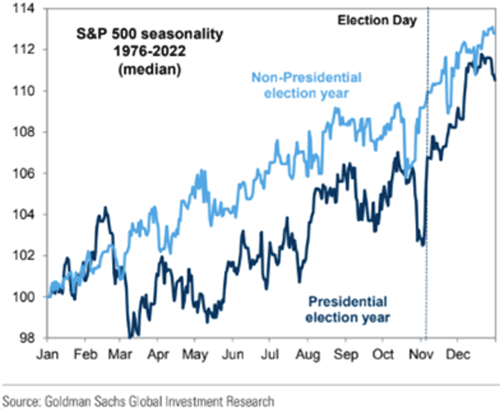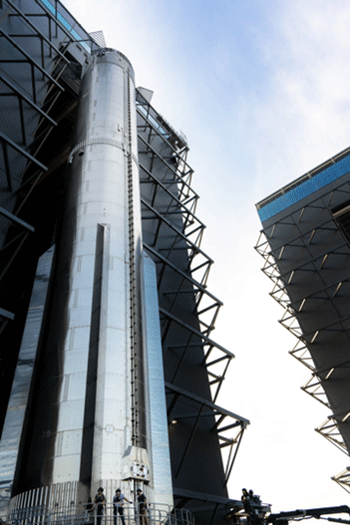Nvidia (NVDA) knocked it out of the park with earnings, again.
It was the most impressive quarter I’ve seen from any company, ever.
Revenues jumped 265% over the past year, while artificial intelligence (AI)-related revenues quintupled!
Anyone who runs a business knows how hard it is to double sales in a year. Nvidia is growing like a nimble startup, but at a multibillion-dollar scale.
I still think it could become the world’s most valuable company before the AI boom is over.
At the start of February, I warned a stock market correction was likely looming.
Yet the S&P 500 made a new record high yesterday, fueled by Nvidia.
Here’s what to do…
1. You should expect stocks to be falling right now.
We just left February, in a presidential election year, so it’s perfectly normal for markets to pull back here.
Look at the dark blue line (election years) in this chart. Markets typically surge out of the gate, then dip right around now:

Source: Goldman Sachs
February is historically the second-worst month for stocks.
The fact that the S&P 500 is bucking these trends and has kept making new all-time highs is important information. It tells us this market has real momentum behind it, and it’s stronger than anyone believes.
So where do markets go from here? I still expect a pullback.
Although the S&P 500 has historically been up three out of every four years since 1980… the average yearly sell-off is 14%.
Lesson: Expect the market to drop around 15% at least once a year.
And as the above chart shows, stocks typically have a weak first half and a strong second half in presidential election years.
Don’t be surprised if the S&P 500 trades sideways until the summer, or even until November.
2. Are you invested in the biotech revolution?
Back in 2011, early Facebook (META) employee Jeff Hammerbacher told Bloomberg:
“The best minds of my generation are thinking about how to make people click ads… that sucks.”
I agree… and I regret that we’ve been in a mini “dark age” for innovation over the past 15 years.
Our brightest kids snagged cushy jobs in Silicon Valley and spent their days gamifying apps and optimizing digital ads. What a waste of talent.
Imagine if instead they chose to build next-gen nuclear reactors… or develop lifesaving drugs?
Well, better late than never.
Scientists are developing ways to “delete” diseases from our bodies.
Gene editing allows doctors to “cut” out bad genes that cause disease and replace them with healthy genes. The first-ever gene editing therapy was approved in America and the UK late last year.
And now, a group of Harvard Medical School doctors have used gene therapy to give hearing to five deaf children.
This treatment has the potential to transform the lives of some 30 million kids who were born deaf.
Scientists are also on the cusp of achieving a holy grail: blood tests that can detect Alzheimer’s at a very early, pre-symptomatic stage.
Researchers in the UK built a ChatGPT-like AI model to sift through 1,500 blood markers.
They were able to predict Alzheimer’s with 90% accuracy… nearly 15 years before people were diagnosed… all with a routine blood test.
By the time we catch Alzheimer’s today, it’s almost always too late.
Early detection means patients could be treated with the first Alzheimer’s drug approved by the FDA last year.
It’s such a shame there are still thousands of uncurable diseases. A mechanic can pinpoint and fix almost any problem with your car instantly. Our bodies are infinitely more complex than a Toyota… but I know we can do a lot better.
We’ve barely scratched the surface of what’s possible when it comes to curing disease and longevity.
I’m confident this biotech revolution will lead to some incredible breakthroughs.
Chris Wood and I recently added one of the world’s best biotech companies to the Disruption Investor portfolio.
3. Today’s dose of optimism…
Elon Musk’s SpaceX built the largest and most powerful rocket ever—the 400-ft. Starship—which is designed to get us to Mars.
Elon recently tweeted this picture of Starship’s Super Heavy rocket booster:

Source: @elonmusk on X
I’m a sucker for man-made beauty, and this is a gem. Fully grown men look like tiny ants next to it.
While “decelerationists” in San Francisco recently set fire to a Waymo robo-taxi, the good guys are trying to get us to the stars.
Yesterday, SpaceX’s Falcon 9 rocket—carrying a cargo lander named “Odysseus”—became the first American spacecraft to land on the moon’s surface since 1972. And Mars-bound Starship is preparing for its third test flight in a couple weeks.
SpaceX is among the most valuable private companies, valued at $175 billion. It’s the best illustration of America waking up from its innovation slumber.
The 2010s were all about building cool apps. Yawn.
Now we’re launching 400 ft. rockets into outer space… which gently touch down on a landing pad once the mission is complete.
Imagine the engineering chops it took to achieve this? I can feel the innovation shift in my bones.
A new tech frontier is opening up. Get ready for energy too cheap to meter… the ability to delete diseases… personalized AI assistants… and Mars-bound rocket ships.
If you can’t tell, I’m fired up for the near future.
Have a great weekend. I’ll see you Monday.

